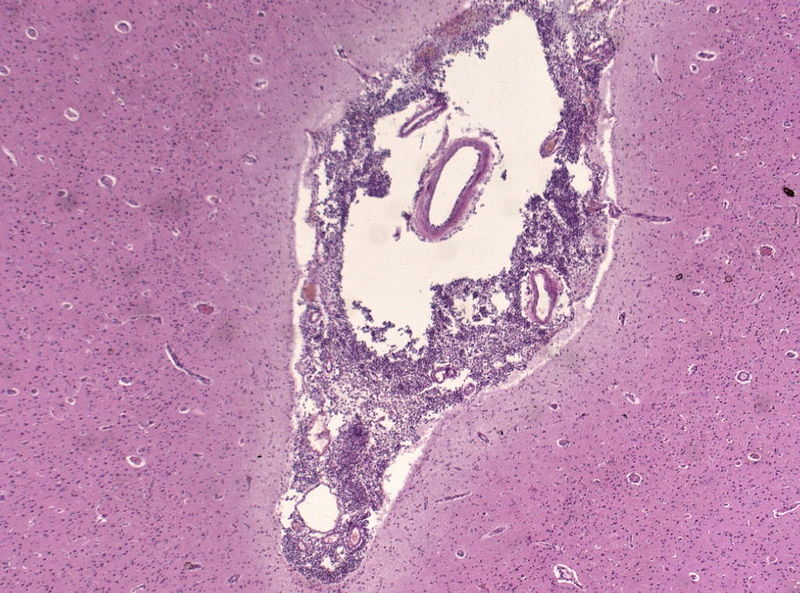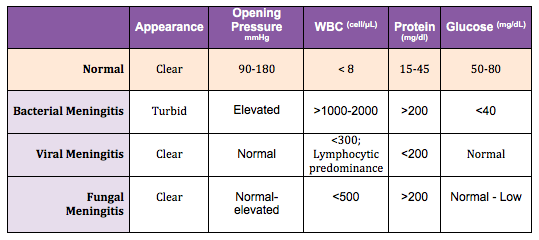[1]
Thigpen MC, Whitney CG, Messonnier NE, Zell ER, Lynfield R, Hadler JL, Harrison LH, Farley MM, Reingold A, Bennett NM, Craig AS, Schaffner W, Thomas A, Lewis MM, Scallan E, Schuchat A, Emerging Infections Programs Network. Bacterial meningitis in the United States, 1998-2007. The New England journal of medicine. 2011 May 26:364(21):2016-25. doi: 10.1056/NEJMoa1005384. Epub
[PubMed PMID: 21612470]
[2]
Feldman C, Anderson R. Meningococcal pneumonia: a review. Pneumonia (Nathan Qld.). 2019:11():3. doi: 10.1186/s41479-019-0062-0. Epub 2019 Aug 25
[PubMed PMID: 31463180]
[4]
Harrison LH. Epidemiological profile of meningococcal disease in the United States. Clinical infectious diseases : an official publication of the Infectious Diseases Society of America. 2010 Mar 1:50 Suppl 2(S2):S37-44. doi: 10.1086/648963. Epub
[PubMed PMID: 20144015]
Level 2 (mid-level) evidence
[5]
Kahler CM, Stephens DS. Genetic basis for biosynthesis, structure, and function of meningococcal lipooligosaccharide (endotoxin). Critical reviews in microbiology. 1998:24(4):281-334
[PubMed PMID: 9887366]
[6]
Persa OD, Jazmati N, Robinson N, Wolke M, Kremer K, Schweer K, Plum G, Schlaak M. A pregnant woman with chronic meningococcaemia from Neisseria meningitidis with lpxL1-mutations. Lancet (London, England). 2014 Nov 22:384(9957):1900. doi: 10.1016/S0140-6736(14)61645-7. Epub 2014 Nov 21
[PubMed PMID: 25457917]
[7]
Bechtle F. [Dental activity in Basutho-Qwa-Qwa]. Zahnarztliche Praxis. 1977 Jun 17:28(12):293-5
[PubMed PMID: 278334]
[8]
Girardin E, Grau GE, Dayer JM, Roux-Lombard P, Lambert PH. Tumor necrosis factor and interleukin-1 in the serum of children with severe infectious purpura. The New England journal of medicine. 1988 Aug 18:319(7):397-400
[PubMed PMID: 3135497]
[9]
Brandtzaeg P, Kierulf P, Gaustad P, Skulberg A, Bruun JN, Halvorsen S, Sørensen E. Plasma endotoxin as a predictor of multiple organ failure and death in systemic meningococcal disease. The Journal of infectious diseases. 1989 Feb:159(2):195-204
[PubMed PMID: 2492587]
[10]
Broome CV. The carrier state: Neisseria meningitidis. The Journal of antimicrobial chemotherapy. 1986 Jul:18 Suppl A():25-34
[PubMed PMID: 3091563]
[11]
Artenstein MS, Gold R, Zimmerly JG, Wyle FA, Schneider H, Harkins C. Prevention of meningococcal disease by group C polysaccharide vaccine. The New England journal of medicine. 1970 Feb 19:282(8):417-20
[PubMed PMID: 4983754]
[12]
Fijen CA, Kuijper EJ, te Bulte MT, Daha MR, Dankert J. Assessment of complement deficiency in patients with meningococcal disease in The Netherlands. Clinical infectious diseases : an official publication of the Infectious Diseases Society of America. 1999 Jan:28(1):98-105
[PubMed PMID: 10028078]
[13]
Miller L, Arakaki L, Ramautar A, Bodach S, Braunstein SL, Kennedy J, Steiner-Sichel L, Ngai S, Shepard C, Weiss D. Elevated risk for invasive meningococcal disease among persons with HIV. Annals of internal medicine. 2014 Jan 7:160(1):30-7. doi: 10.7326/0003-4819-160-1-201401070-00731. Epub
[PubMed PMID: 24166695]
[14]
Bozio CH, Blain A, MacNeil J, Retchless A, Weil LM, Wang X, Jenkins LT, Rodriguez-Rivera LD, Jarashow C, Ngo V, Hariri S, Mbaeyi SA, Oliver S. Meningococcal Disease Surveillance in Men Who Have Sex with Men - United States, 2015-2016. MMWR. Morbidity and mortality weekly report. 2018 Sep 28:67(38):1060-1063. doi: 10.15585/mmwr.mm6738a4. Epub 2018 Sep 28
[PubMed PMID: 30260947]
[15]
Applegate AO, Fong VC, Tardivel K, Lippold SA, Zarate S. Notes from the Field: Meningococcal Disease in an International Traveler on Eculizumab Therapy - United States, 2015. MMWR. Morbidity and mortality weekly report. 2016 Jul 15:65(27):696-7. doi: 10.15585/mmwr.mm6527a3. Epub 2016 Jul 15
[PubMed PMID: 27414068]
[16]
Rouphael NG, Stephens DS. Neisseria meningitidis: biology, microbiology, and epidemiology. Methods in molecular biology (Clifton, N.J.). 2012:799():1-20. doi: 10.1007/978-1-61779-346-2_1. Epub
[PubMed PMID: 21993636]
[17]
MacNeil JR, Blain AE, Wang X, Cohn AC. Current Epidemiology and Trends in Meningococcal Disease-United States, 1996-2015. Clinical infectious diseases : an official publication of the Infectious Diseases Society of America. 2018 Apr 3:66(8):1276-1281. doi: 10.1093/cid/cix993. Epub
[PubMed PMID: 29126310]
[18]
Halperin SA, Bettinger JA, Greenwood B, Harrison LH, Jelfs J, Ladhani SN, McIntyre P, Ramsay ME, Sáfadi MA. The changing and dynamic epidemiology of meningococcal disease. Vaccine. 2012 May 30:30 Suppl 2():B26-36. doi: 10.1016/j.vaccine.2011.12.032. Epub 2011 Dec 15
[PubMed PMID: 22178525]
[19]
Bosis S, Mayer A, Esposito S. Meningococcal disease in childhood: epidemiology, clinical features and prevention. Journal of preventive medicine and hygiene. 2015 Aug 31:56(3):E121-4
[PubMed PMID: 26788732]
[20]
Cohn AC, MacNeil JR, Clark TA, Ortega-Sanchez IR, Briere EZ, Meissner HC, Baker CJ, Messonnier NE, Centers for Disease Control and Prevention (CDC). Prevention and control of meningococcal disease: recommendations of the Advisory Committee on Immunization Practices (ACIP). MMWR. Recommendations and reports : Morbidity and mortality weekly report. Recommendations and reports. 2013 Mar 22:62(RR-2):1-28
[PubMed PMID: 23515099]
[21]
Fitzgerald D, Waterer GW. Invasive Pneumococcal and Meningococcal Disease. Infectious disease clinics of North America. 2019 Dec:33(4):1125-1141. doi: 10.1016/j.idc.2019.08.007. Epub
[PubMed PMID: 31668194]
[22]
Hill DJ, Griffiths NJ, Borodina E, Virji M. Cellular and molecular biology of Neisseria meningitidis colonization and invasive disease. Clinical science (London, England : 1979). 2010 Feb 9:118(9):547-64. doi: 10.1042/CS20090513. Epub 2010 Feb 9
[PubMed PMID: 20132098]
[23]
Johri S, Gorthi SP, Anand AC. Meningococcal Meningitis. Medical journal, Armed Forces India. 2005 Oct:61(4):369-74. doi: 10.1016/S0377-1237(05)80071-1. Epub 2011 Jul 21
[PubMed PMID: 27407812]
[24]
Dwilow R, Fanella S. Invasive meningococcal disease in the 21st century—an update for the clinician. Current neurology and neuroscience reports. 2015 Mar:15(3):2. doi: 10.1007/s11910-015-0524-6. Epub
[PubMed PMID: 25637287]
[25]
Heckenberg SGB, de Gans J, Brouwer MC, Weisfelt M, Piet JR, Spanjaard L, van der Ende A, van de Beek D. Clinical features, outcome, and meningococcal genotype in 258 adults with meningococcal meningitis: a prospective cohort study. Medicine. 2008 Jul:87(4):185-192. doi: 10.1097/MD.0b013e318180a6b4. Epub
[PubMed PMID: 18626301]
[26]
Thompson MJ, Ninis N, Perera R, Mayon-White R, Phillips C, Bailey L, Harnden A, Mant D, Levin M. Clinical recognition of meningococcal disease in children and adolescents. Lancet (London, England). 2006 Feb 4:367(9508):397-403
[PubMed PMID: 16458763]
[27]
Verghese A, Gallemore G. Kernig's and Brudzinski's signs revisited. Reviews of infectious diseases. 1987 Nov-Dec:9(6):1187-92
[PubMed PMID: 3321367]
[28]
Tacon CL, Flower O. Diagnosis and management of bacterial meningitis in the paediatric population: a review. Emergency medicine international. 2012:2012():320309. doi: 10.1155/2012/320309. Epub 2012 Sep 20
[PubMed PMID: 23050153]
[29]
El Bashir H, Laundy M, Booy R. Diagnosis and treatment of bacterial meningitis. Archives of disease in childhood. 2003 Jul:88(7):615-20
[PubMed PMID: 12818910]
[30]
Bryant PA, Li HY, Zaia A, Griffith J, Hogg G, Curtis N, Carapetis JR. Prospective study of a real-time PCR that is highly sensitive, specific, and clinically useful for diagnosis of meningococcal disease in children. Journal of clinical microbiology. 2004 Jul:42(7):2919-25
[PubMed PMID: 15243039]
[31]
Bourke TW, Fairley DJ, McKenna JP, Coyle PV, Shields MD. Clinical Evaluation of Streptococcus pneumoniae Polymerase Chain Reaction in Children with Suspected Septicemia. The Pediatric infectious disease journal. 2015 Nov:34(11):1276-7. doi: 10.1097/INF.0000000000000877. Epub
[PubMed PMID: 26457903]
[32]
Notomi T, Okayama H, Masubuchi H, Yonekawa T, Watanabe K, Amino N, Hase T. Loop-mediated isothermal amplification of DNA. Nucleic acids research. 2000 Jun 15:28(12):E63
[PubMed PMID: 10871386]
[33]
Pollard AJ, Nadel S, Ninis N, Faust SN, Levin M. Emergency management of meningococcal disease: eight years on. Archives of disease in childhood. 2007 Apr:92(4):283-6
[PubMed PMID: 17376933]
[34]
Crosswell JM, Nicholson WR, Lennon DR. Rapid sterilisation of cerebrospinal fluid in meningococcal meningitis: Implications for treatment duration. Journal of paediatrics and child health. 2006 Apr:42(4):170-3
[PubMed PMID: 16630316]
[35]
Tunkel AR, Hartman BJ, Kaplan SL, Kaufman BA, Roos KL, Scheld WM, Whitley RJ. Practice guidelines for the management of bacterial meningitis. Clinical infectious diseases : an official publication of the Infectious Diseases Society of America. 2004 Nov 1:39(9):1267-84
[PubMed PMID: 15494903]
Level 1 (high-level) evidence
[36]
Grubbauer HM, Dornbusch HJ, Dittrich P, Weippl G, Mutz I, Zobel G, Georgopoulos A, Fotter R. Ceftriaxone monotherapy for bacterial meningitis in children. Chemotherapy. 1990:36(6):441-7
[PubMed PMID: 2292206]
[37]
Stephens DS, Greenwood B, Brandtzaeg P. Epidemic meningitis, meningococcaemia, and Neisseria meningitidis. Lancet (London, England). 2007 Jun 30:369(9580):2196-2210. doi: 10.1016/S0140-6736(07)61016-2. Epub
[PubMed PMID: 17604802]
[38]
Gardner P. Clinical practice. Prevention of meningococcal disease. The New England journal of medicine. 2006 Oct 5:355(14):1466-73
[PubMed PMID: 17021322]
[40]
. Analysis of endemic meningococcal disease by serogroup and evaluation of chemoprophylaxis. The Journal of infectious diseases. 1976 Aug:134(2):201-4
[PubMed PMID: 823273]
[42]
Nadel S, Kroll JS. Diagnosis and management of meningococcal disease: the need for centralized care. FEMS microbiology reviews. 2007 Jan:31(1):71-83
[PubMed PMID: 17233636]
[43]
Cartwright K, Reilly S, White D, Stuart J. Early treatment with parenteral penicillin in meningococcal disease. BMJ (Clinical research ed.). 1992 Jul 18:305(6846):143-7
[PubMed PMID: 1515827]
[44]
van de Beek D, de Gans J, Spanjaard L, Weisfelt M, Reitsma JB, Vermeulen M. Clinical features and prognostic factors in adults with bacterial meningitis. The New England journal of medicine. 2004 Oct 28:351(18):1849-59
[PubMed PMID: 15509818]
[45]
Solnick JV. Treatment with moxifloxacin versus standard therapy for community-acquired pneumonia. Clinical infectious diseases : an official publication of the Infectious Diseases Society of America. 2006 Jul 1:43(1):109; author reply 110-1
[PubMed PMID: 16758427]
[46]
Bloch D, Murray K, Peterson E, Ngai S, Rubinstein I, Halse TA, Ezeoke I, Miller L, Arakaki L, Ramautar A, Antwi M, Del Rosso P, Dorsinville M, Clark S, Halbrook M, Kennedy J, Braunstein S, Weiss D. Sex Difference in Meningococcal Disease Mortality, New York City, 2008-2016. Clinical infectious diseases : an official publication of the Infectious Diseases Society of America. 2018 Aug 16:67(5):760-769. doi: 10.1093/cid/ciy183. Epub
[PubMed PMID: 29509877]
[47]
Hoffman O, Weber RJ. Pathophysiology and treatment of bacterial meningitis. Therapeutic advances in neurological disorders. 2009 Nov:2(6):1-7. doi: 10.1177/1756285609337975. Epub
[PubMed PMID: 21180625]
Level 3 (low-level) evidence
[48]
Crum-Cianflone N, Sullivan E. Meningococcal Vaccinations. Infectious diseases and therapy. 2016 Jun:5(2):89-112. doi: 10.1007/s40121-016-0107-0. Epub 2016 Apr 16
[PubMed PMID: 27086142]
[49]
Mitchell GK, Tieman JJ, Shelby-James TM. Multidisciplinary care planning and teamwork in primary care. The Medical journal of Australia. 2008 Apr 21:188(S8):S61-4
[PubMed PMID: 18429739]


